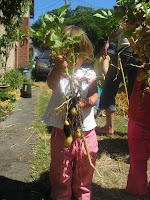
It seems to me that this year a lot of people decided to grow potatoes in a new or different way. My sister called me early in the spring to tell me about the tire method, in which you plant your seed potatoes in an old tire, and then pile tires upon tires as the plants grow. The idea is that when it comes time to harvest, all you do is pull apart the layers of tires and voila! No dig potato harvesting.
For our part, we decided to grow potatoes in straw this year. First, we used the sheet mulching method of applying layers of newspaper over lawn, and added a layer of compost to that. On top of this, we added our seed potatoes which were the lovely and delicate fingerling potatoes.

Then, instead of adding more soil, we covered the seed potatoes in straw. As the potato plants grew, we continued t
 o add more layers of straw, keeping the whole plot well-watered throughout the season.
o add more layers of straw, keeping the whole plot well-watered throughout the season.Eventually the plants flowered, and then after they died back, we called our friends over for a little harvest party. Harvesting, of course, is the most satisfying part of gardening, and we were all pretty excited to see what we had under our layers of straw. The whole idea with the straw is that the plant produces its little gem
 s in the clean straw, and you have a nice, perfectly clean potato to harvest.
s in the clean straw, and you have a nice, perfectly clean potato to harvest.As we peeled back the layers, however, we found that most of our potatoes had not produced plants along the stems as they were meant to, but had produced at the base of the plants, and yes, we had wonderful, perfect, clean little fingerlings! They were very easy to harvest because we were just pluc
 king them from the first compost layer, and we did not have to use a shovel at all. Even my little Abby was able to help with the harvest, much to her delight.
king them from the first compost layer, and we did not have to use a shovel at all. Even my little Abby was able to help with the harvest, much to her delight.And my son Lucas, very much into numbers at the moment, did the final count, which came out at 129 little blond potatoes.
Overall, I think that the straw method was a success, and was certainly an easy way to grow the potatoes, right from start to finish.
Another bonus is that now we have a lovely little garden bed to layer up, lasagna garden style, and plant our winter vegetable crop to get us through the cold, wet months of the year to come.




No comments:
Post a Comment